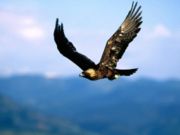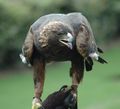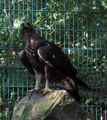Golden Eagle
2007 Schools Wikipedia Selection. Related subjects: Birds
| iGolden Eagle | ||||||||||||||
|---|---|---|---|---|---|---|---|---|---|---|---|---|---|---|
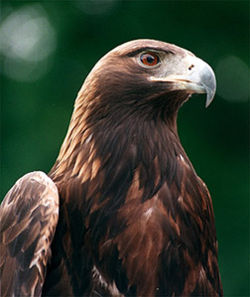 |
||||||||||||||
|
|
||||||||||||||
 Least Concern (LC) |
||||||||||||||
| Scientific classification | ||||||||||||||
|
||||||||||||||
|
|
||||||||||||||
| Aquila chrysaetos Linnaeus, 1758 |
||||||||||||||
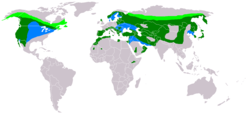 World distribution of the golden eagle
Light green = Nesting area Blue = Wintering area Dark green = All year distribution |
The Golden Eagle (Aquila chrysaetos) is one of the best known birds of prey in the Northern Hemisphere. Like all eagles, it belongs to the family Accipitridae.
There are six subspecies of Golden Eagle that differ slightly in size and plumage. They can be found in different parts of the world:
- A. c. chrysaetos: Eurasia except iberian peninsula, east to western Siberia.
- A. c. canadensis: North America.
- A. c. homeryi: Iberian peninsula and North Africa, east to Turkey and Iran.
- A. c. japonica: Japan and Korea.
- A. c. daphanea: From southern Kazakhstan east to Manchuria and south-west China including northern India and Pakistan.
- A. c. kamtschatica: Eastern Siberia, from the Altay to the Kamchatka Peninsula.
Golden Eagles are renowned for their striking appearance and combining power with agility in flight.
Distribution
At one time, the Golden Eagle lived in temperate Europe, North Asia, North America, North Africa and Japan. In most areas this bird is now a mountain-dweller, but in former centuries it also bred in the plains and the forests. In recent years it has started to breed in lowland areas again (Sweden, Denmark).
There was a great decline in Central Europe, and the Golden Eagle is now restricted to the higher central Appennine regions of Italy (the regional capital of Abruzzo is named after the latin/Italian word for eagle, L'Aquila), and the Alps. In Britain, there are about 420 pairs left in the Scottish highlands, and between 1969 and 2004 they bred in the English Lake District. In North America the situation is not as dramatic, but there has still been a noticeable decline.
Efforts are being made to re-introduce the species in Glenveagh National Park, County Donegal, Ireland, where they had been extinct since the early 20th Century. Forty-six birds have been released into the wild from 2001 to 2006, with at least three known female fatalities since then. It is intended to release a total of sixty birds, to ensure a viable population.
Reproduction
A pair of Golden Eagles remains together for life. They build several eyries within their territory and use them alternately for several years. The nest consists of heavy tree branches, upholstered with grass.
Old eyries may be 2 metres (6.6 ft) in diameter and 1 metre (3.3 ft) in height, as the eagles enlarge their nests every year. If the eyrie is situated on a tree, supporting tree branches may break because of the weight of the nest.
The female lays two eggs between January and May (depending on the area). After 45 days the young hatch. They are entirely white and are fed for fifty days before they are able to make their first flight attempts and eat on their own. In most cases only the older chick, which takes most of the food, survives, while the younger one dies without leaving the eyrie.
Physical characteristics
Adult Golden Eagles have an average length of 75-85 cm (30-34"), a wingspan of 150-210 cm (59-83"), and a weight of 3-5 kg (7-11 lb). As in all birds of prey, the females are generally slightly larger than the males. The largest golden eagle on record measured 41 inches (103cm) in length and weighed in an excess of 9kg (20.245lb). It was a female found in Spain. She also held the record for the tallest Golden eagle, standing 66 cm (26 inches).
The plumage colours range from black-brown to dark brown, with a striking golden-buff crown and nape, which give the bird its name. The juveniles ressemble the adults, but have a duller more mottled appearance. Also they have a white-banded tail and a white patch at the carpal joint, that gradually disappear with every moult until full adult plumage is reached in the fifth year.
Hunting
Golden Eagles often have a division of labour while hunting: one partner drives the prey to its waiting partner. They have very good eyesight and can spot prey from a long distance. The talons are used for killing and carrying the prey, the beak is used only for eating. The talons of a Golden Eagle are thought to be more powerful than the hand and arm strength of any human being. Their prey includes marmots, hares and mice, and sometimes birds, martens, foxes and young deer. Large mammals like chamois or adult deer can only be taken if they are wounded or sick.
In Central Asia, Golden Eagles sometimes are trained for falconry: in Kazakhstan there are still hunters using these eagles in order to catch deer and antelopes; in Kyrgyzstan hunters will show outsiders how to hunt foxes [ ]; and in Mongolia they are traditionally trained to hunt wolves. Some of the animals that Golden Eagles have been trained to kill can weigh 45 kg (100 lb).
